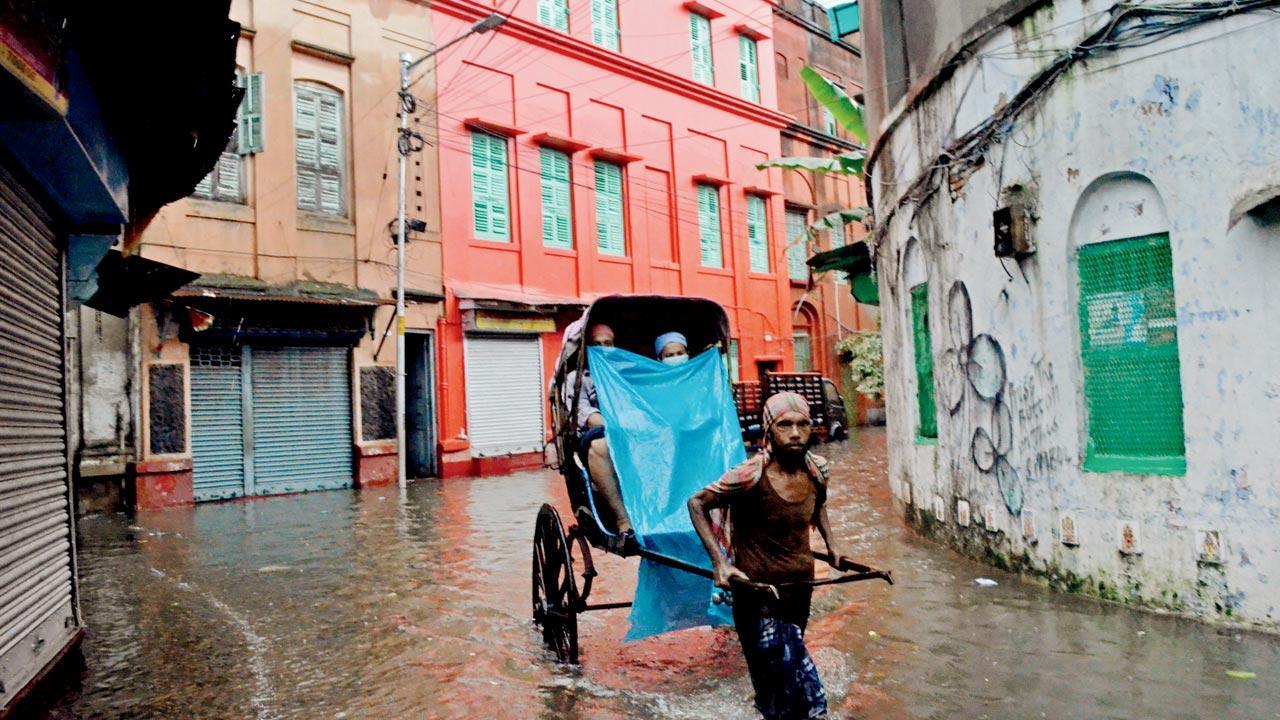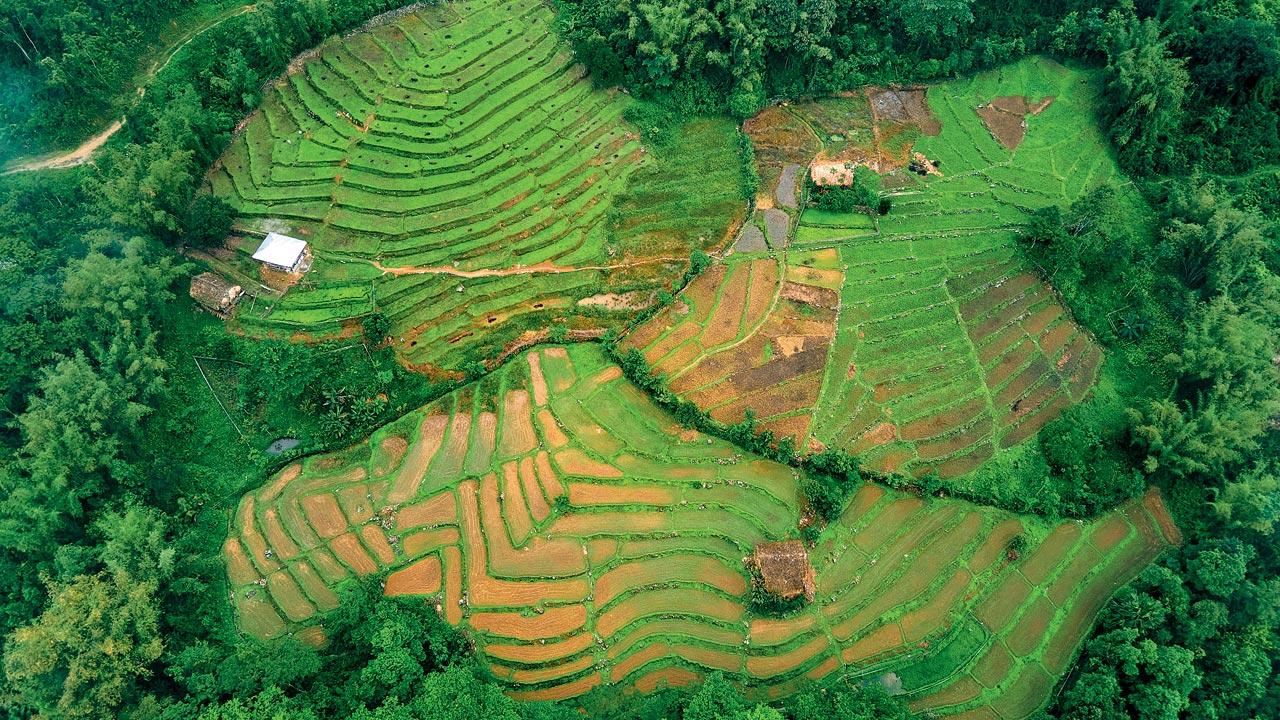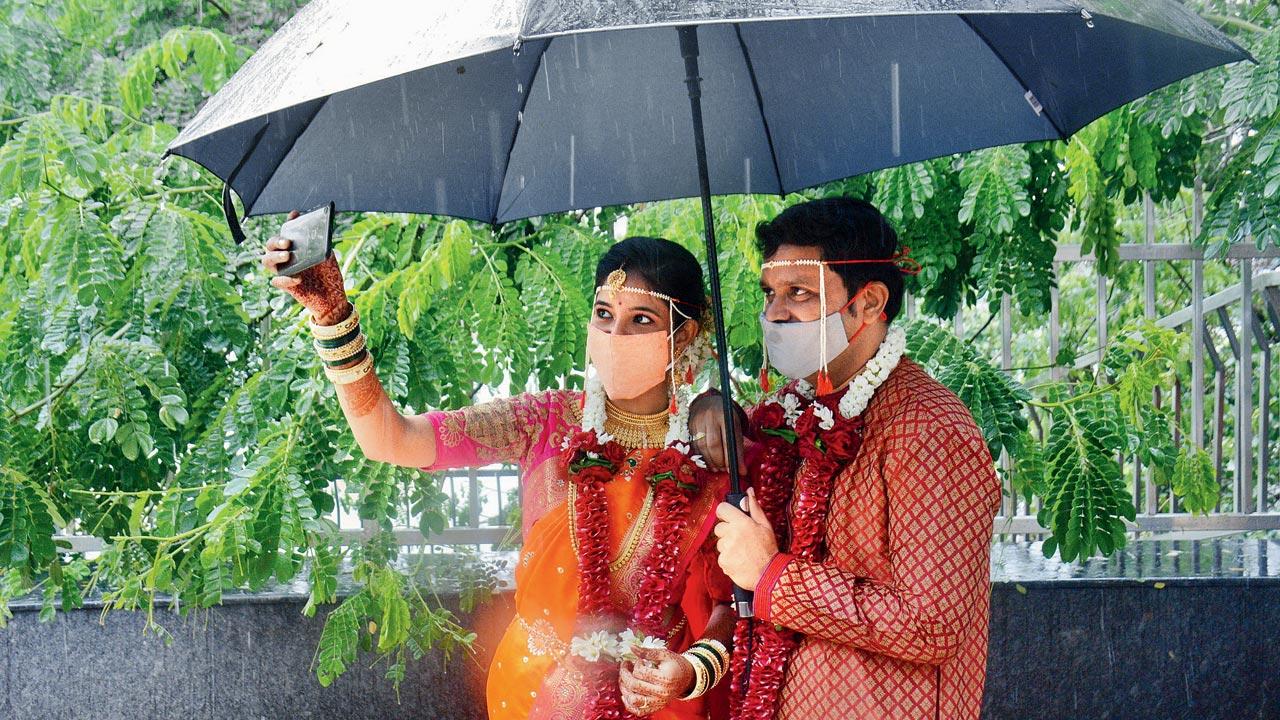The rain by any other name is just as wet? Not if you look closely at the Indian regional lexicon for the weather phenomenon

A hand-rickshaw puller is seen wading through a flooded street in Kolkata, in a file photo from 2021. In Bengali, flood-causing rain is aptly called khichuri brishti because it makes you reach for a comforting bowl of steaming hot khichdi with ghee. Pic/Getty Images
It started with a drop: A gifted story-teller colleague was telling us about “murgeshwar”, the rain that pours down continuously for 20 days and fills up wells and tanks. “We’d be imprisoned indoors, and when the sun peeked for a few hours, we’d rush out to dry our washed clothes and aam papads,” she said about vacations with her grandparents in Mangalore.
ADVERTISEMENT
Different types of rain have different words in Indian languages. If the Scots can have over 400 words for snow, and the Inuit people 50, surely Indian language lexicons are awash with words for Indra’s gift.
Unabashed words-nerds in the Sunday mid-day newsroom, we ran out to catch them like bored children to unseasonal downpour. Everyone across this newspaper’s editorial departments—sports, entertainment, even our colleagues at the group’s Urdu newspaper Inquilab, hurriedly dialled their parents to ask them the names for different kinds of rain.
 An aerial shot of terrace farms during the monsoons in Siang, Arunachal Pradesh. Rain that’s less than a drizzle is called sipsipia boroxun by the Ahomya
An aerial shot of terrace farms during the monsoons in Siang, Arunachal Pradesh. Rain that’s less than a drizzle is called sipsipia boroxun by the Ahomya
Every language, we found, had one for the rain that comes when the sun is out—the oon paus (rain during sunshine) as it is called in Marathi. It’s also called kolhyacha (wolf’s) or landgyacha (fox’s) lagna or wedding, or kaksialer biyer logno (the fox’s wedding mahurat, with kaksial being a kind of fox) in Bengali. In rural dialects of the state, it is also called khak siyal er biye.
However, our favourite terms for it come from the regional departments of colloquialism: Nagda paus (naked rain) in Marathi, nagodiyo varsaat in Kutchhi, naago varsaad in the Parsi dialect of Gujarati; and monkey-donkey wedding in the playgrounds of Orlem, Bandra and Vasai.
Sophisticated and poetic Urdu, judging us crude city folk from a corner with ittar behind its ears, calls it baaraan-e-aaftaabi; and of course, it has a name for moonlit showers too—baaraan-e-mehtaabi.
 If it’s the non-stop variety that irritates by adding to the city’s chaos, it’s the rip-rip paus for Maharashtrians. A married couple takes a selfie outside the Marriage Registrar’s Office in Thane in a file photo from July 2021. Pic/Getty Images
If it’s the non-stop variety that irritates by adding to the city’s chaos, it’s the rip-rip paus for Maharashtrians. A married couple takes a selfie outside the Marriage Registrar’s Office in Thane in a file photo from July 2021. Pic/Getty Images
But let’s start at the first drop: Rohini is what the first pre-monsoon shower in Mangalore is called, Shirley Crasto, our colleague’s aunt, informs us. Gujaratis call relief-bringing rain like this parvatiya; and if it cools the environs down, the Marathi-speaking mandali calls it tushar. “Chaar tushar padun gele tar kasa garva ala, nai? (Haven’t four tushars brought the temperatures down?)” This relief-bringing rain, beneficial to all creatures, is called baaraan-e-rehmat in Urdu.
To the English, a “drizzle” may just be a sprinkle at most, but our subcontinent has names for every incremental degree. It’s called boonda-bandi in most north Indian states—Uttar Pradesh, Rajasthan, Gujarat, and ilshegudi brishti in Bengali. In Telugu, it’s a chinukulu, taraunkha in Punjabi, and kinkinia boroxun in Assamese. Less than a drizzle, and it’s sipsipia boroxun for the Ahomya of Arunachal and Assam. In Tamil, a very light rain is tuli mazhai; light drizzle is tural; and a
heavy drizzle, saral.
In the Havyaka dialect of Karnataka—Ashish Thippanakaje, a student of SDM College in Ujire informs us—it’s tunturu malle. Malle; the rolled ‘l’ is the generic word for rain. Konkanis call it a chiri-chiri paus; if it’s the non-stop variety that irritates by adding to the city’s chaos, it’s the peer-peer or rip-rip paus for Maharashtrians. The spitting variety is called jhir jhir brishti in the Bengali-speaking belt, which calls a scattered shower bikhitto brishti.
Surprisingly, Gujarat—not a rain-ravaged state, Biparjoy excluded—has a wide lexicon. It starts with chhanta or splashes of rain and progresses to fur-fur which barely dampens the skin, then it grows into a jarmar varsaat or fora, which is a proper drizzle, that grows into a kara before it earns the reputation as legitimate rain. Fora is also hail in Kutchi.
When it pours heavily, the kind that washes away all the romance associated with pitter-patter, it’s the dobapita boroxun in Assam and moosaldhaar in many other languages. But that too has as many names as it has varieties: In Gujarat, the heavy olavrushtmi can be a pachediva if accompanied by a wind that bends trees. Jhamb is what Punjabis call rain that’s falling aslant due to the wind. Punjabis call a squall (localised, windy rain) jhaanja, which could elevate into a jhakkad jhaanja, a cyclonic storm.
If it reminds you of a tap running at full force, it’s Gujarat’s nevadhaar varsaat. Careful, this could grow into a ‘double rain’ with large drops: An anradhaar varsaat. If it starts running in streams from thatched roofs that resemble ‘supdis’ or bamboo rice cleaners that separate grain from the chaff, it’s supdadharr varsaat. The paann varsaat waterlogs fields, but thefabangh or vava-ni-jod washes away crops and causes landslides. In Kannada, pushya poorna-risha is temperamental, and flood-causing. The most aptly-named of these is the oti bhari brishti (very heavy rainfall) of Bengali called khichuri brishti because it makes you reach for a comforting bowl of steaming hot khichdi with ghee. But matters could get worse: It may end in pralaya, which is what a deluge is called in Havyaka.
Hindi’s barfbari—hail storm—is Gujarat’s hailey, Tamil Nadu’s pani mazhai, and Urdu’s zaala bari. Then we have the oddities: Akali paus is unpredictable, unseasonable rain that visits Maharashtra in January or February, says Martha Bhosale, mother to our Sunday team colleague. Shravani paus is fickle-minded, it drizzles one minute and then the sun shines relentlessly, but themb-themb paus is back a few hours later. Gujarat’s vahnik varsaat is convectional rain that falls only in one spot because there is no wind to carry the cloud away, just like Punjab’s jhaala. Mol varsaat that falls in the month of May ruins crops, while aadre (Kannada), which falls at the end of June or July is capricious. Winter rains in Jodhpur, caused by cyclones, are called mavath in Marwari, informs Amit Pareek, a marketing head at an IT company.
Then there’s the biblical variety: Tamil Nadu’s rare fish rain or meen mazhai is caused by tornadic waterspouts that picks up aquatic creatures such as fish and frogs and carries them away for several kilometres. Blood rain or chehapai/ratta mazhai, as experienced by Kerala in 2001 is when the water was coloured by airborne spores of a local algae variety.
But as another Sunday mid-day colleague puts it, no matter the type of downpour, by August, when Mumbai is sick of clothes that don’t dry, potholes, algae that makes you slip and fall, any expletive will do.
With inputs from Sundari Iyer
 Subscribe today by clicking the link and stay updated with the latest news!" Click here!
Subscribe today by clicking the link and stay updated with the latest news!" Click here!







